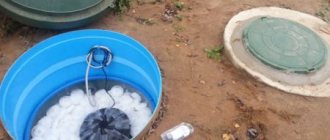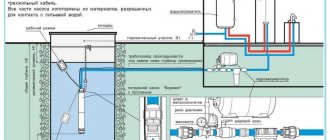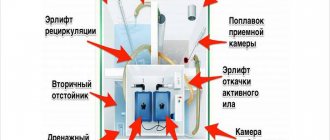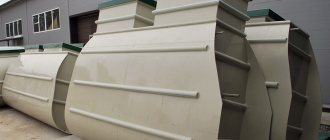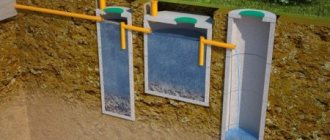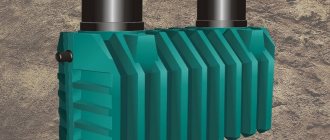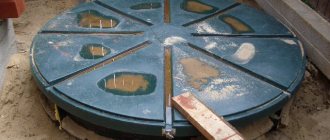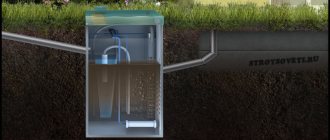Sewage is one of the benefits of civilization, which significantly makes life easier for a person, making it more convenient and comfortable. In large cities, as a rule, it is possible to connect to a centralized system, so the issue of waste disposal does not arise. But in the countryside, where cottages and country houses are being built, as well as in towns and villages, you need to look for alternative options. The most successful solution is to install a cleaning system. The design of septic tanks of the latest models is quite complex; a multi-stage sewerage treatment scheme is provided, resulting in the effective decomposition of sewage.
Design features and septic tank design
A septic tank is a modern wastewater treatment system. Autonomous sewerage can be installed in almost any area, regardless of the type of soil and the level of groundwater. The main function of a wastewater treatment plant is the collection and filtration of domestic wastewater. Septic tanks have a number of advantages over traditional cesspools. They are easy to use, do not require frequent pumping, do not contaminate the soil, and have a long service life. The design of autonomous sewers is quite complex; let’s consider it in more detail.
- Tanks for collecting and settling wastewater. Storage containers can be made of brick, reinforced concrete rings, metal or plastic. Today, polypropylene and fiberglass tanks are popular due to their high strength and rigidity.
- Pipeline. The system must have two pipes: inlet and outlet. The pipes are installed at an angle to ensure efficient fluid flow between the tanks.
- Service elements. Hatches and inspection wells are installed so that you can gain unhindered access to the system, inspect it, carry out diagnostics in case of deterioration in functioning, and carry out repair measures.
- Ventilation. Bacteria are involved in the process of decomposition of sewage. To ensure the normal functioning of microorganisms, it is necessary to take care of the ventilation of the septic tank. Proper air exchange helps maintain optimal temperature and remove methane.
The modern market offers a wide range of wastewater treatment plants manufactured in factories. They can consist of two or three compartments, provide for the arrangement of filtration fields, the use of aerobic and anaerobic bacteria, etc. In cottages and country houses for permanent residence, we recommend installing productive autonomous sewerage systems such as Tank, Topas, Topol, Unilos, Eurobion, etc.
Note! If you want to save money, you can make a septic tank yourself. Instead of purchased tanks, you can use containers made of concrete rings or bricks. Such designs are relevant in dachas and in houses intended for temporary residence. They are affordable, but are not designed to process large amounts of wastewater.
Ways to independently arrange septic tanks ↑
To organize a full-fledged cleaning system on the site, it is not necessary to purchase ready-made stations, especially if people live in the country only in the summer. You can make a full-fledged septic tank with your own hands without pumping, using available materials:
- Brick.
- Concrete or reinforced concrete rings.
- Purchased plastic (fiberglass) tanks.
Cleaning tanks made of solution and rings ↑
It is impossible to build a septic tank that looks like a neat platform with a hatch on the site without equipment.
The structure is invisible on the site
To install the tanks you will have to dig a pit. The volume, depth and dimensions of the pit are determined based on preliminary calculations of the volume of the chambers. The structure is completely dug into the ground; only an inspection hatch remains on the surface, through which cleaning is carried out and, in structures with biofilters, the outlet of the ventilation pipe. The work is carried out during the dry season, when it is possible to save on pumping groundwater - in late summer or early autumn.
Diagram of a three-chamber system with a filter well
If concrete rings are used, then their installation is carried out sequentially, with the installation of overflow pipes. A drainage layer of bulk materials is laid on the compacted base. The number of rings is calculated so that the volume of the primary settling tank can accommodate the predicted amount of wastewater.
The internal space is equipped with ready-made biofilters and mechanical filters. The outside walls are treated with insulating materials. It is advisable to backfill with gravel in a circular manner. The upper part, located above the freezing point, must be thermally insulated.
An example of manufacturing a two-chamber monolithic septic tank from a solution
The tank is poured from the solution using pre-prepared formwork, while simultaneously constructing internal partitions according to the number of required compartments. Waterproofing additives are added to the solution.
Brick septic tank: budget design ↑
The most economical tank is made of brickwork. They are laid in one brick in the shape of a well or a quadrangular container. But brick is a porous material, and to ensure the tightness of the structure, the inner surface of the walls is treated with insulating cement mortar.
Rectangular brick tank with division into compartments
To protect against freezing, the structure is insulated. Inside, the container is divided into compartments. For seasonal use, choose the simplest schemes with one or two filter compartments. The only advantage of a brick septic tank is its low cost. The disadvantage is fragility, lack of tightness and the length of time required to install the walls.
High-speed arrangement of a cleaning station from plastic containers ↑
You can completely recreate the design of a factory septic tank without pumping using ready-made plastic tanks, containers, and cubes. There are products reinforced along the outer perimeter with a steel mesh, which protects the plastic from deformation.
Containers reinforced with mesh and equipped with seals, hatches, and overflow
The advantage of using plastic containers is durability and ease of installation. The material is easy to process; cutting out the required number of holes for installing overflows is not difficult. Plastic does not rot, does not allow water to pass through, and does not freeze - you can save on hydro- and thermal insulation of the structure.
Full station made from a plastic tank
To form multi-chamber septic tanks, containers of different volumes are selected. The internal filling depends on the chosen filtration method - based on a plastic body, you can construct both a septic tank with biofiltration and a ground treatment system.
Operating principle of autonomous sewage system
The operation of any treatment plant is based on the principles of sedimentation and filtration of sewage waste in a natural or forced way. For more effective cleaning, biofilters or special enzyme preparations can be used. The mechanism of operation of septic tanks is quite complex and consists of several stages.
- Primary cleaning. Sewage flows through a pipeline removed from the house into the first tank. Heavy suspensions settle to the bottom, oils and fats rise up and flow into the next compartment.
- Waste decomposition. The sewage that sank to the bottom in the first chamber disintegrates to form water, carbon dioxide and a thick mass, which gradually decreases in volume and turns into sludge. The cleaning efficiency in this chamber is up to 60%.
- Secondary cleaning. In the second chamber, small particles are decomposed and fats and oils are diluted. To speed up this process, special preparations with bacteria and organic compounds are added to the chamber.
- Additional treatment. The further path of the wastewater depends on the type of septic tank. For post-treatment, infiltration, a drainage well, or a filtration field can be used. Cleaning efficiency – 90-95%. The water is practically pure and can be used for economic purposes and for watering fields.
Sludge and mechanical impurities from the first compartment must be periodically removed. As a rule, calling a sewer truck is required no more than once a year. But still, when installing an autonomous sewer system, care should be taken to organize unhindered access for the sewer truck to the septic tank.
Design and preparatory activities
The main requests for the installation of septic tanks are indicated in SNiP (building codes and regulations). Before starting the installation of a treatment plant, it is necessary to coordinate the project with the sanitary and epidemiological station (SES), otherwise the costs may be in vain.
Standards governing the placement of a septic tank on a site Source optopg.ru
When developing a project for installing a septic tank, first of all you need to take into account the requirements of SNiP and SES, and they inform about the following:
- The shortest distance to the building is 5 m.
- The distance to the nearest water intake (well, borehole) is 50 m.
- Distance to running water (river, stream) – 10 m.
- The interval to a source with standing water is 30 m.
To competently draw up a project for a septic tank, you need to imagine the prices for installation work, and also know the approximate prices of materials. In addition to this cost, one must take into account the cost of earthworks, which are inevitable for such a treatment facility.
Preparatory work
Before you begin installing the septic tank, you need to make preparations. It involves excavation work and calculation of parameters that influence the correct choice of location and efficiency of the treatment plant.
Preparatory work includes:
- Analysis of the soil structure and topography of the planned site for a septic tank.
- Checking the depth of groundwater. The depth of the installation, as well as the filtration method, depend on this parameter.
When groundwater is high, the design of a volatile septic tank with a drainage pump is most often used. Source tvoy-septik.ru
- Preparing the site for the future septic tank. (Cleaning the area from foreign objects).
- Marking.
- Digging a hole for a structure and trenches for sewer pipes.
After the pit has been dug with dimensions for installation, installation can begin.
Features of the operation of different types of septic tanks
The design of septic tanks is constantly being improved. Manufacturers are working to improve the performance properties and reduce the cost of treatment units. The range of autonomous sewers is rapidly expanding. Based on the principle of operation, structures are divided into three categories: storage, with soil treatment, and with biological treatment.
Autonomous storage sewage system
In fact, this is one or another modification of a regular drain pit. The sewage system is a sealed tank made of durable, reliable material that is resistant to mechanical stress. The waste flows in through the inlet valve. They are collected here and temporarily stored. As soon as the tank is full, the septic tank must be pumped out. To increase ease of use, the septic tank can be equipped with a wastewater level sensor with an alarm, a check valve that does not allow waste to move in the opposite direction.
Systems with soil post-treatment
Septic tanks with soil post-treatment are classified as overflow-type units. Autonomous sewerage of this type is quite convenient and easy to use. The system includes two or three tanks, as well as a filtration field, where sewage is purified by 90-95% and becomes suitable for use for economic purposes. Moving from one container to another, the wastewater settles, mechanical particles and solid deposits settle at the bottom, and the already purified and clarified water is poured into the next compartment.
Important! In settling tanks, wastewater can be purified by only 65-70%. This is not enough to dump waste into the ground. If you release from the last compartment directly into the soil, contamination of the soil and groundwater may occur.
If you do not have experience and knowledge in such matters, it is better to entrust the installation of a septic tank to specialists. Mistakes can be costly. Organizing soil purification requires a lot of time and effort. There are three ways to implement it.
- Filtration well. This option is suitable for sandy soils and non-plastic sandy loams. Brick, reinforced concrete rings, and stone are used to construct the facility. At the bottom of the well it is necessary to make a drainage layer of crushed stone. The optimal thickness is 1 m.
- Underground filtration. Labor-intensive, but effective and durable method. It is necessary to allocate space on the territory for a sand and gravel site. There are perforated pipes on it, connected to the last compartment of the septic tank. The liquid enters the drainage through the pipeline, seeps through the cushion, is cleaned, and seeps into the soil without polluting it.
- Trench system. A relevant solution for clay areas, as well as for areas where a reservoir is located. The design consists of two pipes. The liquid enters the filtration field, seeps through perforated pipes into the sand and crushed stone bed, is purified while passing through it, accumulates in drainage pipes, and almost pure water is transported to its destination, from where it can be used to water the garden, for example.
The main functional element of this type of septic tank is not a complex of tanks, but a multilayer drainage filter. The area of the filtration field must be quite large, so this solution is not suitable for cramped areas where there is little space.
Septic tanks with deep biological treatment
Autonomous sewers with biological treatment are rapidly gaining popularity. These are not separate tanks connected by a pipe, but a single, solid tank divided into several sections. An excellent choice for a summer house or country house, it effectively cleans sewer drains, dispersing any particles. The end result is water purified to 98%.
The sewage coming from the house in the first compartment is cleaned due to the principle of gravity. Mechanical particles and solid waste settle at the bottom of the container. The liquid flows into the next chamber, where microorganisms are collected, which thoroughly clean the wastewater from waste products. The last section contains a multi-stage filter system, after which the water becomes practically clean, suitable for disposal into the soil or for use for economic purposes.
Advantages of septic tanks with biological treatment:
- safety – the purified liquid, saturated with organic compounds, does not harm plants and can be used as a fertilizer;
- Installation near water bodies is not prohibited;
- effective sewage treatment;
- simple maintenance;
- long service life;
- the strength and reliability of the device, because for the manufacture of septic tanks metal or impact-resistant plastic resistant to mechanical loads is used.
As for the shortcomings, there are them too. You regularly need to pour preparations with bacteria into the bacteriological chamber, and this is a constant expense. The filter may fail; replacing it is quite expensive. The price of biological septic tanks is significantly higher than that of other types of treatment facilities.
Stages of ground treatment
After a septic tank with anaerobic treatment, the wastewater has a low level of purification, up to 60%, and therefore it is mandatory to undergo ground treatment in infiltrators, on ground treatment fields or in drainage wells. Drainage wells can be constructed in sandy and sandy loam non-plastic soils. To make such a well, reinforced concrete rings, brick or stone masonry are usually used. Crushed granite or gravel is used as a filter component. The filter component layer is 1 m or more.
The procedure for constructing underground filtration fields, which can be installed on clay soils and in areas where it is possible to discharge treated wastewater into an unused reservoir:
- at a depth of 0.5-1.8 m, a gravel-sand cushion with a height of at least 200 mm is arranged;
- Perforated drainage pipes are laid in two tiers on the filter layer;
- The wastewater treated in the septic tank enters the pipes of the first tier, and then is collected in the lower pipe - the drain - through which it is sent to a reservoir or to the terrain.
For stable operation, it is necessary to regularly pump out the septic tank.
You may also be interested in our class=”aligncenter” width=”1280″ height=”853″[/img] Sewage
Cleaning drains and sewer pipes
Mechanical cleaning of sewer pipes
| How to contact us: | |||
| +7 | Request a call back | ||
| [email protected] | Order a service online | ||
Schemes of operation of popular industrial models
Industrial autonomous sewers are relevant in cases where it is necessary to organize the treatment and disposal of a large amount of wastewater coming from several sources. Septic tanks of this type are suitable for servicing production facilities, shopping and entertainment centers, and several residential buildings. The system consists of several reservoirs connected by pipelines and pumping stations. Each container has a filter that traps dirt. The main advantages of sewerage include fast and effective cleaning. The system is capable of processing wastewater within 24 hours.
Treatment system Tank
One of the most popular septic tanks is the Tank. The basis of the treatment plant is a solid cast tank, divided into sections. Stiffening ribs 17 mm thick strengthen and toughen the structure, making it more resistant to the negative effects of external factors. A sealed tank is installed on different soils, regardless of composition. An obstacle to the installation of the Tank is not the high level of groundwater. The model has a block-modular structure, due to which it is possible to increase the productivity of the septic tank.
Stages of sewage treatment in an autonomous sewer Tank:
- sewage enters the receiver, to the bottom of which solid, indecomposable impurities settle, then the clarified liquid flows into the next compartment;
- in the second chamber, fat particles are caught and wastewater is purified with anaerobic bacteria;
- in the third compartment microorganisms live, and an infiltrate is installed, due to which deep cleaning of wastewater is carried out.
The result is a liquid that is 75-80% purified. To ensure more thorough cleaning, it is necessary to remove the pipe into a filtration well filled with crushed stone.
Topas – sewage system with biofiltration
Topas is a popular septic tank model that is perfect for servicing country cottages and private mansions. The high performance of autonomous sewage systems ensures fast, effective wastewater treatment. The system body is made of durable three-layer foamed polymer. The internal space is divided into two chambers. The first compartment receives and accumulates sewer racks. A special sensor is installed here. The internal device signals the filling level of the septic tank, and also ensures spontaneous activation of the pump to pump wastewater into the next chamber.
An aerator is installed in the second compartment, which is driven by two compressors located in a sealed housing. It is responsible for the constant supply of air, which is necessary for the normal functioning of microorganisms responsible for processing sewage.
Non-volatile septic tank Triton
Triton is one of the most effective, simple and affordable septic tanks. A full-fledged model is ideal for cottages and houses. Triton-Mini is a modification for summer cottages, saunas, holiday homes and other objects that are not used for permanent residence. High efficiency of sewage treatment is achieved through a combination of mechanical and biological filtration with a soil treatment system. The advantages of the cleaning unit include excellent ergonomics, simplicity of design, and compact dimensions.
A septic tank consists of two tanks that are connected to each other in two places: at the top and at the bottom. Solid impurities settle at the bottom, clarified water flows into the next compartment.
Rodlex storage tank
Rodlex is an economical option, an alternative to a septic tank made of rings. The plastic tank has a one-piece construction and is made of high-strength polymer. The extended neck prevents sewage overflow. The hatch prevents the unpleasant odor from spreading throughout the area.
Advantages of Unilos septic tanks
Autonomous sewage system Unilos is designed for long-term operation in extreme conditions. A very durable and reliable body, made of rigid polypropylene, reinforced with stiffening ribs. The internal space is divided into the following compartments:
- a volumetric receiving chamber in which sewage waste settles;
- an aeration chamber designed to decompose organic matter due to the action of aerobic bacteria;
- sludge chamber - sludge sediment accumulates and decomposes here;
- secondary settling tank is the final stage of wastewater treatment from foreign impurities.
The peculiarity of the model is that it even processes activated sludge. The septic tank is easy to use without cleaning. If you have to pump out sludge, it will be very rare. Unilos has a number of advantages compared to other models.
- Environmental friendliness. A high level of wastewater purification is ensured by multi-stage filtration. The water at the end is clear, not cloudy, odorless, 98% purified, and can be used for watering fields.
- Tightness. The body is solid, leaks are excluded, and the risk of untreated wastewater getting into the ground is minimized.
- Compact sizes. The model is suitable for installation even in small areas. You don't need a lot of space.
- Easy installation. The design is quite simple and durable. There is no need to concrete the walls of the pit before installing the tank. The polypropylene body, reinforced with stiffening ribs, provides the septic tank with high resistance to ground shifts and other external influences.
- Wide range of models. The line includes ergonomic, affordable options for cottages, saunas, houses for non-permanent residence, as well as productive sewer systems for servicing industrial facilities.
- Comfort. During operation of the septic tank, no unpleasant odor leaks into the area. There is also no risk of overfilling the container, because various sensors and indicators are installed inside.
Advice! Despite the fact that installing a septic tank is not particularly difficult, you should not undertake this task if you do not have enough knowledge and experience. Leave the installation to professionals. Proper connection will ensure that the autonomous sewer system functions effectively over a long period.
Content
- How a septic tank works in a private house: principle and design
- Stages of septic tank operation
- Popular septic tank models
- What is a septic tank with biological treatment by aerobic microorganisms and how does it work?
- Stages of ground treatment
Country houses, cottage and holiday villages are often located far from centralized sewer systems. One of the options for organizing an autonomous sewer system is the installation of a septic tank, usually consisting of two or more chambers. The more compartments there are in the septic tank, the more effective the wastewater treatment. To obtain wastewater at the outlet suitable for discharge into the ground or reservoir, drainage fields or wells are installed. When choosing the type of septic tank, they are guided by the number of residents, the desired level of wastewater treatment and the planned budget. Before installing or constructing a septic tank, you need to find out the rules of local legislation that regulate the distance from the treatment plant to residential buildings, fences, roads, sources of drinking water, and green spaces.
How to choose a septic tank?
Which septic tank to choose? There is no clear answer to this question. To select the most suitable model, it is necessary to measure the approximate volume of sewage that will flow into the septic tank per day. This figure depends on the number of residents, as well as on the equipment of the house with household appliances. The next parameter is the level of groundwater and the type of soil. You also need to consider the purpose of the house. If a family lives here permanently, a more powerful treatment plant will be required than for a dacha or summer house.
When choosing a septic tank, it is important to consider the following characteristics:
- productivity (volume of processed waste per day);
- number and volume of chambers;
- operating principle of the treatment unit;
- body material and wall thickness;
- vertical or horizontal location of the tank;
- company manufacturer;
- price of autonomous sewerage.
The cost of savings models varies in the range of 24-81 thousand rubles. Options with soil filtration will cost more - from 59 to 90 thousand rubles. And the most expensive systems are those with deep biopurification. Their price can reach 160 thousand rubles. Setting up a sewer system with your own hands will cost less, about 15-20 thousand rubles.
Choice of design: which type of septic tank is better ↑
It is definitely better to choose a factory-made septic tank for servicing a private home. A professionally calculated, designed and installed system is a guarantee that you will not have to constantly modify an imperfect septic tank or regularly call specialists to pump out waste.
It is better to entrust the choice of septic tank design to professionals: it is difficult to independently calculate the required volume, select the type and power of internal equipment. And it is almost impossible to carry out installation without the involvement of a team of workers and equipment.
Installation of septic tanks: some advice from professionals
Let's consider what difficulties may arise when installing a finished septic tank. First, you need to select a reliable, competent installation company that will install the treatment facility.
Secondly, take into account what material the septic tank is made of - propylene or polyethylene, and what the thickness of the walls is. Thirdly, it is necessary to inquire not only about the price of the equipment and the cost of installation, but also the cost of maintaining the service (the cost of pumping out).
It is advisable to purchase septic tanks from well-known brands, since in this case you can hope that both spare parts and a service company are available in the given region.
To determine the size of the septic tank, you need to take into account, first of all, the number of water taps installed in the house and the one-time discharge of water.
If a small number of people live in the house, then you can consider the option of a small septic tank of the “Kid” type Source microles.ru
Materials for the construction of chambers
You need to start building a two-chamber septic tank with your own hands by choosing the material for the chambers. In addition, you need to draw up a diagram of the overflow septic tank, and also think about the organization of post-treatment.
These can be filtration fields or an infiltrator. Both of these devices use the same operating principle. Once on the filtration fields, the liquid is filtered mechanically and purified biologically (the principle of aerobic biopurification is used).
Let's start with choosing the material. When constructing septic tanks that do not require frequent pumping, it is advisable to use the following materials with your own hands:
- Reinforced concrete. There are two options here: purchasing ready-made well rings or building a monolithic septic tank. Having chosen the option with rings, you will need to take time to seal the chambers at the joints of individual elements. In addition, such a septic tank is difficult to build with your own hands; the use of lifting equipment will be required.
- Brick. If a home craftsman has experience in bricklaying, then he can build brick chambers quite quickly.
Advice! When choosing brick as a material for constructing a septic tank, it is necessary to take a certain type of material, namely clinker. This type of brick is made from baked clay, so it is not destroyed by water. But it is not advisable to use ordinary porous or silicate bricks.
- Plastic. If the master has ready-made plastic containers of the required volume at his disposal, then the construction of a septic tank will be extremely simple and convenient. Most often, Eurocubes are used to construct chambers.
Advice! For example, when building a septic tank with your own hands, using a metal tank or barrel as a chamber is not the best choice. Even with careful anti-corrosion treatment, such a structure is unlikely to last more than 5-6 years.
Model selection
The choice of tank volume, number of chambers and operating principle of a septic tank for a summer residence and for a home largely depends on operating conditions. The functionality of a treatment facility at a dacha, where people come for a few hours or days, differs from how a septic tank works in a private house with a shower, kitchen, toilet and water-consuming household appliances (washing machines, dishwashers, etc.).
In a house with permanent residence, not only is the volume of wastewater larger, but its composition is also more complex, which includes both organic and chemically active substances. In this case, it is important to ensure the possibility of high-quality cleaning for drainage into the ground, so that you do not have to constantly call a sewer truck. Investment in the purchase of an effective aerobic energy-dependent septic tank and the costs of its operation in this case will pay off. But during breaks in operation at a summer cottage, bacteria can die.
We talked about what products are available for septic tanks and cesspools in another article. Features of the use of chemical and biological drugs.
You will learn how to make a wastewater treatment plant from Eurocubes yourself by reading this article.
You will find a review of models of peat country toilets here https://okanalizacii.ru/postrojki/tualet/torfyanoj-tualet-dlya-dachi-kakoj-vybrat.html
Location of the septic tank
The place for installing a septic tank should be at a distance of 2 m or more from the house.
- If you have sandy soils - from 5 m. It is necessary to take into account that the farther the septic tank is located, the deeper the sewer pipe may be. It must be remembered that sewer pipes for external use are red-brown in color, their wall thickness is 3.2 mm. The pipes are laid with a special plumbing slope. Sewer pipes do not freeze in winter, unlike water pipes, since they are always empty. Under the pipes it is necessary to make a sand bedding with mandatory compaction of at least 150 mm.
- The location must be chosen so that the parking lot is located 2 meters from the septic tank.
- You should not make a pedestrian zone .
- Septic tank covers must be located above ground level. To avoid groundwater from entering the technological cracks, it is forbidden to bury the septic tank entirely underground along with its lids.
- drinking wells and shallow wells up to 25 m deep and the point of discharge of purified water from a sealed septic tank should be located 20 - 25 m from each other . If you have sandy soils, this standard increases to 50 m.
- An important condition for comfort on a personal plot is the presence of a vent riser inside the house. If the house is built according to the project, then it is present. If there is no vent riser at home, then it is necessary to install an external vent riser. If there is no vent riser outside or inside the house, an unpleasant odor will appear.
- It is also necessary to remember that any septic tank needs to be pumped out. There are no septic tanks without pumping. This means that it is necessary to provide access to a special vehicle for pumping out sludge. The length of the hose of such a machine is from 10 to 50 m.
December 22, 2015


